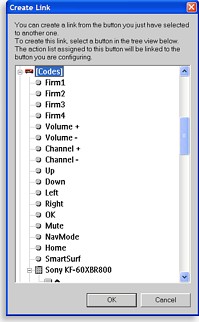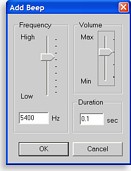|
...Continued from Page 15.
When “easier” may not be.
The ProntoEdit NG software has been designed to help make programming the hardware easier. It succeeds in all situations except two: assigning preprogrammed codes and learning infrared commands.

Adding database codes. |
The “Add IR Code” menu command merges preprogrammed code selection and learning onto a single screen. If you’re after a database code, just select the device type, brand and code number from the pull-downs on top, then pick the exact command from a comprehensive list. It’s more difficult to determine the correct code number in ProntoEdit NG than on the remote, as there are no automated search routines and every button in a device must be configured individually. A “Test” button can be used to send the selected code through an attached remote, but that’s only useful if your computer is near the device being programmed.
If you wish to learn a command, ignore these selections and, after connecting the remote to the computer and waiting several seconds for it to initialize, click the “Learn IR” button at the bottom. A window will appear and wait for you to send a command to the TSU3000. If everything works, the window disappears and the code is learned – the remote does not beep. A hex version of the code can be viewed by clicking the “View/Edit IR” button, but this window cannot remain open during learning. ProntoEdit NG supports the standard Pronto hex code format.

Viewing a learned code. |
Unfortunately, it takes a significantly longer amount of time to learn codes in ProntoEdit NG than it does on the base remote, since there are so many more steps required for each button. The problem is compounded by the software’s tendency to learn “dirty” codes, along with difficulties communicating with the remote over USB. Sometimes it starts working perfectly, then suddenly starts claiming that the remote is disconnected or not responding, requiring a reboot of the Pronto or a restart of ProntoEdit NG to fix. Several times the remote even locked up while attempting to learn. In the end, it’s far quicker to download the file to the remote, learn every code, and upload it back to the software.
Linking, jumping & macros.
The “Create Link” function is used to alias one button to another button’s command list. Aliasing codes is a way to both save memory and make future file editing easier. Instead of learning the same command in multiple places, learn it once and wherever else it’s needed, link to that original location.

Linking to buttons. |
Selecting “Create Link” displays a nested view of all devices in the file, similar to the main file navigation tree. Double-clicking on a device opens a list of all hard buttons and pages under that device. Double-clicking on a page delves even further into individual commands. The alias window remembers the last selected command between multiple aliases, making it quicker to create repetitive macros such as for favorite channels where three or four codes must be aliased from a single device. It is not possible to alias directly to a device’s action list as it was in the original ProntoEdit, although it’s still possible to link macros to other macros.

Customizing beeps. |
Activity-based macros may require jumping to a specific page at the end, an operation that can be accomplished with “Create Jump”. New to the Pronto family (but not Marantz’s version of the Pronto), the TSU3000 can have multiple page jumps on the same button. So, lengthy macros could display a “Please Wait...” screen at the beginning, then jump to the final device page when finished. LCD-based macros can be cancelled by pressing the same button a second time.
As on the remote, macros can contain delays and beeps. ProntoEdit NG permits each delay to range from 0.1 to 32.0 seconds, and beeps can be customized in tone, length and volume. Industrious individuals can even create simple music!
| 
